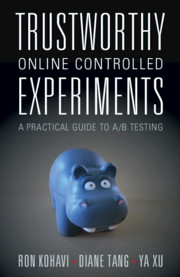Refine search
Actions for selected content:
48294 results in Computer Science
Modeling industrial engineering change processes using the design structure matrix for sequence analysis: a comparison of multiple projects
- Part of
-
- Journal:
- Design Science / Volume 6 / 2020
- Published online by Cambridge University Press:
- 16 March 2020, e6
-
- Article
-
- You have access
- Open access
- HTML
- Export citation
Demonstration, extension, and refinement of the re-proposed notion of design abduction
-
- Article
-
- You have access
- Open access
- HTML
- Export citation

Trustworthy Online Controlled Experiments
- A Practical Guide to A/B Testing
-
- Published online:
- 13 March 2020
- Print publication:
- 02 April 2020
A Review of Dynamic Balancing for Robotic Mechanisms
-
- Article
-
- You have access
- Open access
- Export citation
ENTROPY-BASED AND NON-ENTROPY-BASED GOODNESS OF FIT TEST FOR THE INVERSE RAYLEIGH DISTRIBUTION WITH PROGRESSIVELY TYPE-II CENSORED DATA
-
- Journal:
- Probability in the Engineering and Informational Sciences / Volume 35 / Issue 3 / July 2021
- Published online by Cambridge University Press:
- 11 March 2020, pp. 631-649
-
- Article
- Export citation
Interdisciplinary engineering of cyber-physical production systems: highlighting the benefits of a combined interdisciplinary modelling approach on the basis of an industrial case
- Part of
-
- Journal:
- Design Science / Volume 6 / 2020
- Published online by Cambridge University Press:
- 11 March 2020, e5
-
- Article
-
- You have access
- Open access
- HTML
- Export citation
User research enabled by makerspaces: bringing functionality to classical experience prototypes
-
- Article
-
- You have access
- Open access
- HTML
- Export citation
Fine-grained analysis of language varieties and demographics
-
- Journal:
- Natural Language Engineering / Volume 26 / Issue 6 / November 2020
- Published online by Cambridge University Press:
- 10 March 2020, pp. 641-661
-
- Article
- Export citation
Classification of regional and genre varieties of Chinese: A correspondence analysis approach based on comparable balanced corpora
-
- Journal:
- Natural Language Engineering / Volume 26 / Issue 6 / November 2020
- Published online by Cambridge University Press:
- 09 March 2020, pp. 613-640
-
- Article
- Export citation
Matching biodiversity and ecology ontologies: challenges and evaluation results
- Part of
-
- Journal:
- The Knowledge Engineering Review / Volume 35 / 2020
- Published online by Cambridge University Press:
- 09 March 2020, e9
-
- Article
- Export citation
Computable analysis with applications to dynamic systems
-
- Journal:
- Mathematical Structures in Computer Science / Volume 30 / Issue 2 / February 2020
- Published online by Cambridge University Press:
- 09 March 2020, pp. 173-233
-
- Article
-
- You have access
- Open access
- Export citation
On minimal Ramsey graphs and Ramsey equivalence in multiple colours
- Part of
-
- Journal:
- Combinatorics, Probability and Computing / Volume 29 / Issue 4 / July 2020
- Published online by Cambridge University Press:
- 09 March 2020, pp. 537-554
-
- Article
- Export citation
Out of sync, out of society: Political beliefs and social networks
-
- Journal:
- Network Science / Volume 8 / Issue 3 / September 2020
- Published online by Cambridge University Press:
- 09 March 2020, pp. 445-468
-
- Article
- Export citation
COMPARISONS ON LARGEST ORDER STATISTICS FROM HETEROGENEOUS GAMMA SAMPLES
-
- Journal:
- Probability in the Engineering and Informational Sciences / Volume 35 / Issue 3 / July 2021
- Published online by Cambridge University Press:
- 09 March 2020, pp. 611-630
-
- Article
- Export citation
A model for the dynamics of face-to-face interactions in social groups
-
- Journal:
- Network Science / Volume 8 / Issue S1 / July 2020
- Published online by Cambridge University Press:
- 06 March 2020, pp. S4-S25
-
- Article
- Export citation
Nonuniform language in technical writing: Detection and correction
-
- Journal:
- Natural Language Engineering / Volume 27 / Issue 3 / May 2021
- Published online by Cambridge University Press:
- 06 March 2020, pp. 293-314
-
- Article
- Export citation
Toll-based reinforcement learning for efficient equilibria in route choice
- Part of
-
- Journal:
- The Knowledge Engineering Review / Volume 35 / 2020
- Published online by Cambridge University Press:
- 05 March 2020, e8
-
- Article
- Export citation
Long-term cultivation using ineffective MDM2 inhibitor concentrations alters the drug sensitivity profiles of PL21 leukaemia cells
-
- Journal:
- Experimental Results / Volume 1 / 2020
- Published online by Cambridge University Press:
- 05 March 2020, e5
-
- Article
-
- You have access
- Open access
- HTML
- Export citation
Saccharide sources do not influence the biofilm formation in Scedosporium/Lomentospora species
-
- Journal:
- Experimental Results / Volume 1 / 2020
- Published online by Cambridge University Press:
- 05 March 2020, e1
-
- Article
-
- You have access
- Open access
- HTML
- Export citation
New tools for the visualization of glial fibrillary acidic protein in living cells
-
- Journal:
- Experimental Results / Volume 1 / 2020
- Published online by Cambridge University Press:
- 05 March 2020, e4
-
- Article
-
- You have access
- Open access
- HTML
- Export citation



